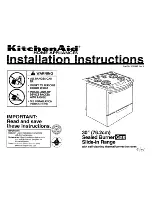
Care and cleaning of the range.
30
Operating Instructions
Installation Instructions
Safety Information
Troubleshooting T
ips
Customer Service
With proper care, the porcelain enamel finish on the inside of the
oven—top, bottom, sides, back and inside of the door—will stay new-
looking for years.
Let the range cool before cleaning. We recommend that you wear
rubber gloves when cleaning the range.
Soap and water will normally do the job. Heavy spattering or
spillovers may require cleaning with a mild abrasive cleaner. Soapy,
wet metal pads may also be used.
Do not allow food spills with a high sugar or acid content (such as milk, tomatoes,
sauerkraut, fruit juices or pie filling) to remain on the surface. They may cause a
dull spot even after cleaning.
Household ammonia may make the cleaning job easier. Place
1/2 cup in a shallow glass or pottery container in a cold oven
overnight. The ammonia fumes will help loosen the burned-on
grease and food.
If necessary, you may use an oven cleaner. Follow the package
directions.
Do not spray oven cleaner on the electrical controls and switches because it could
cause a short circuit and result in sparking or fire.
Do not allow a film from the cleaner to build up on the temperature sensor—it
could cause the oven to heat improperly. (The sensor is located at the top of the
oven.) Carefully wipe the sensor clean after each oven cleaning, being careful not
to move the sensor as a change in its position could affect how the oven bakes.
Do not spray any oven cleaner on the oven door, handles or any exterior surface of
the oven, cabinets or painted surfaces. The cleaner can damage these surfaces.
Oven Interior (non-self clean models)
















































